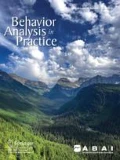Abstract
Noncontingent reinforcement (NCR) is the response-independent delivery of a reinforcer (Vollmer, Iwata, Zarcone, Smith, and Mazaleski in Journal of Applied Behavior Analysis 26: 9–21 1993). Two staff members (preservice education majors) implemented NCR procedures for two students with autism spectrum disorder (ASD) who exhibited problem behavior and attended an after-school program. The amount of training on NCR and procedural fidelity was measured for each staff member, and the effects of the treatment on problem behavior were evaluated. Results indicate NCR is a low-effort procedure that reduced problem behavior of two participants with ASD.
• NCR can both reduce problem behaviors of clients who engage in difficult behaviors (Carr, Severtson, & Lepper, 2009).
• NCR can be used for clients for whom extinction-induced behaviors are dangerous (Tucker, Sigafoos, and Bushell in Behavior Modification, 22: 529–547, 1998).
• Nonbehavioral providers can implement NCR with high fidelity, making it a good procedure to use when collaborating with other professionals (teachers, SLP, parents, etc.; Matson, 2009).
• NCR can be used when clinicians first begin working with a client until more detailed interventions are created.


Similar content being viewed by others
References
Austin, J. L., & Soeda, J. M. (2008). Fixed-time teacher attention to decrease off-task behaviors of typically developing third graders. Journal of Applied Behavior Analysis, 41, 279–283.
Carr, J. E., Severtson, J. M., & Lepper, T. L. (2009). Noncontingent reinforcement is an empirically supported treatment for problem behavior exhibited by individuals with developmental disabilities. Research in Developmental Disabilities, 30, 44–57.
Dunlap, G., Kern, L., dePerczel, M., Clarke, S., Wilson, D., Childs, K. E., et al. (1993). Functional analysis of classroom variables for students with emotional and behavioral challenges. Behavioral Disorders, 18, 275–291.
Hagopian, L. P., Fisher, W. W., & Legacy, S. M. (1994). Schedule effects of noncontingent reinforcement on attention-maintained destructive behavior in identical quadruplets. Journal of Applied Behavior Analysis, 27, 317–325.
Matson, J. L. (2009). Applied behavior analysis for children with autism spectrum disorders. New York: Springer.
O’Callaghan, P. M., Allen, K. D., Powell, S., & Salama, F. (2006). The efficacy of noncontingent escape for decreasing children’s disruptive behavior during restorative dental treatment. Journal of Applied Behavior Analysis, 39, 161–171.
Riley, J. L., McKevitt, B. C., Shriver, M. D., & Allen, K. D. (2011). Increasing on-task behavior using teacher attention delivered on a fixed-time schedule. Journal of Behavioral Education, 20, 149–162. doi:10.1007/s10864-011-9132-y.
Tomlin, M., & Reed, P. (2012). Effects of fixed-time reinforcement delivered by teachers for reducing problem behavior in special education classrooms. Journal of Behavioral Education, 21, 150–162. doi:10.1007/s10864-012-9147-z.
Vollmer, T. R., Iwata, B. A., Zarcone, J. R., Smith, R. G., & Mazaleski, J. L. (1993). The role of attention in the treatment of attention-maintained self-injurious behavior: noncontingent reinforcement and differential reinforcement of other behavior. Journal of Applied Behavior Analysis, 26, 9–21.
Compliance with Ethical Standards
Informed Consent
Informed consent was obtained from all individual participants included in the study.
Author information
Authors and Affiliations
Corresponding author
Rights and permissions
About this article
Cite this article
Noel, C.R., Getch, Y.Q. Noncontingent Reinforcement in After-School Settings to Decrease Classroom Disruptive Behavior for Students with Autism Spectrum Disorder. Behav Analysis Practice 9, 261–265 (2016). https://doi.org/10.1007/s40617-016-0117-0
Published:
Issue Date:
DOI: https://doi.org/10.1007/s40617-016-0117-0




